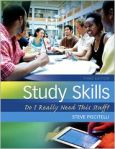What we have to remember is that the explosion of information
does not necessarily equate to an explosion of credible knowledge.
Video recommendation for the week:
Maybe it is the heat of the political campaign season. The ads, debates, robocalls, and the talking (screaming?) heads on television have reinforced the importance of being information literate. I am again reminded that study skills go beyond the classroom. They are life skills. If we are not able to distinguish fact from fiction in what we hear, see, and read then we are in for a long political season.
Information literacy concerns itself with locating, evaluating, and using information in an effective and efficient manner. “Information” can come in text, video, photos, recorded interviews, or music.
Video recommendation #2 for the week:
Up until a few short years ago, the ground zero for finding information was your local library. Whether you were looking for a newly-released book, doing research for history class, searching for a video, or wanting to scan the local newspaper, the library represented THE place to satisfy your research needs. You might even have found a small coffee shop nearby. Kind of a one-stop-intellectual opportunity.
Today we live in an age that allows us to get information instantaneously from virtually anywhere in the world. As of 2003, the World Wide Web (www) contained seventeen times the volume of information found in print collections in the Library of Congress. (Qualman 2010)
What we have to remember is that the explosion of information does not necessarily equate to an explosion of credible knowledge.
There are four components of information literacy—and due to the availability of SO MUCH information, it is even more imperative to understand and adhere to these four steps of becoming information literate.
- Understand what information we need.
- Know where to find the information we need.
- Evaluate the information we find (is it “good” or “bad”?).
- Organize and use the information in a logical and appropriate manner.
To sum it up: “Today’s complex informational system creates challenges. The key is to know not just where to look for information but also how to separate the good from the bad, the informative from the misleading.” (Piscitelli, 71)
Bonus Section: What is Your Digital Tattoo—and How is it Connected to Information Literacy?
I have written on this blog before about the Power of Social Media. Social media has become THE game changer in how we communicate. It is not a fad. It is not going away. It is not static—it continues to change daily. And it IS part of the new information literacy. What we have to do is learn how to use it effectively—and with integrity and dignity.
I used to talk about “digital footprints” as a metaphor for the impressions we leave when we post anything online. I have come to learn that a “footprint” is not an adequate mental representation. Instead, think “digital tattoo.” This more adequately represents what we develop online—a lasting image. Consider that when you post anything online you are creating your online persona—your digital reputation. It consists of your words (email, texts, tweets, status updates) and your images (photos and videos). It has the potential of being found by anyone. The following video is of a conversation I had with a musician friend who uses social media for his music.
Here is a shortlist of tips on creating an appropriate online profile (and reputation):
- Be honest.
- Pay attention to your grammar, spelling, and sentence structure.
- Pay attention to the messages you convey with your words (classy, sassy, goofy, professional).
- Be appropriate with images you post.
- Think of your mentor and your mother! Would you want them to read what you have just put out there for the world to see?
The bottom line is to maintain a sense of civility and propriety. Just because you have communicated does not mean you have connected. Be respectful.
Remember, social media is a resource to use. Use it well. Information literacy is a skill. Develop it purposefully.
For more on information literacy and social media, see my book Study Skills: Do I Really Need This  Stuff? 3rd edition (Pearson Education). Please visit my website (www.stevepiscitelli.com), contact me at steve@stevepiscitelli.com, or visit Pearson Education, Amazon and Barnes and Noble.
Stuff? 3rd edition (Pearson Education). Please visit my website (www.stevepiscitelli.com), contact me at steve@stevepiscitelli.com, or visit Pearson Education, Amazon and Barnes and Noble.
Enjoy your week—and H.T.R.B. as needed!
Thank you for taking the time to read my blog post. Please pass it (and any of the archived posts on this site) along to friends and colleagues. You can also follow me on Twitter, LinkedIn, and Facebook. If you get a chance, visit my Facebook page (www.facebook.com/stevepiscitelli) and click on the “LIKE” button. Also, if you have suggestions for future posts, leave a comment. Have a wonderful week!
© 2012. Steve Piscitelli and Steve Piscitelli’s Blog.

Mention of Civility is SO important. Glad you included it as a study/life skill.
‘Always appreciate you!!
LikeLike
Thanks, Mimi! It is simple…but often neglected, isn’t it. Thanks for reading.
LikeLike
Pingback: (#136) A Blogger’s Retrospective: 2012 in Review « Steve Piscitelli's Blog
Awesome site you have here but I was curious if you knew of any community forums that cover
the same topics talked about in this article? I’d really
love to be a part of community where I can get comments from
other knowledgeable individuals that share the same interest.
If you have any recommendations, please let me know.
Thank you!
LikeLike
Pingback: (#433) Verifying Truth | The Growth and Resilience Network®